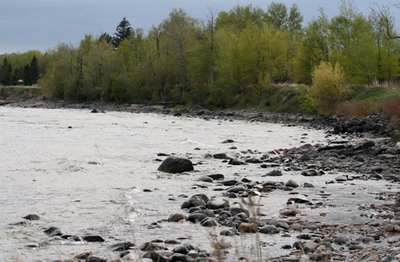 On my solo birding day on Sunday, I checked out two peninsulae that project out into Lake Superior. One is called Bark Point, and it's long and narrow, with sloughs along the east edge. The sun was hitting beautifully off the rounded lake rocks and pewter water. You can see how far behind the trees are in this frigid lakeshore place--they're just coming out. Ours in southern Ohio are almost at full Juneness, even with the April cold spell that froze their first set of leaves right off.
On my solo birding day on Sunday, I checked out two peninsulae that project out into Lake Superior. One is called Bark Point, and it's long and narrow, with sloughs along the east edge. The sun was hitting beautifully off the rounded lake rocks and pewter water. You can see how far behind the trees are in this frigid lakeshore place--they're just coming out. Ours in southern Ohio are almost at full Juneness, even with the April cold spell that froze their first set of leaves right off.A pair of common mergansers, which breed in large cavities in sycamores, usually, were paddling close into shore. This is the only duck in which the female sports a crest and the male doesn't. He does have a puffy pompadour on his hind neck (kind of like BOTB's).
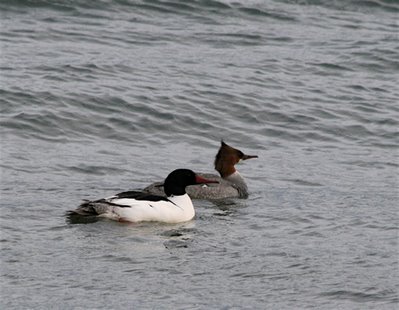
I moved slowly closer to the mergansers as they paddled away. Got one more shot of the drake, lovely bird that he is.
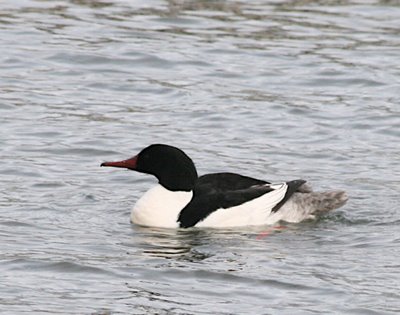 I stepped out onto a little wooden dock and two different ducks burst right out from under it. From the intricate pattern of their wings, I knew I had red-breasted mergansers this time!
I stepped out onto a little wooden dock and two different ducks burst right out from under it. From the intricate pattern of their wings, I knew I had red-breasted mergansers this time!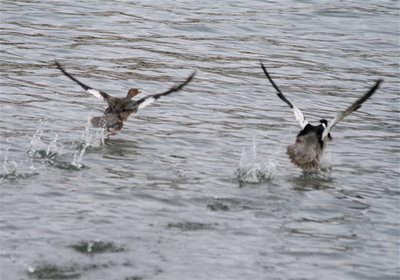 I fired away as they pattered off into the lake. I felt so at one with my camera, so happy to be recording them to look at later. The moment was so fleeting, and I knew I was capturing something gorgeous.
I fired away as they pattered off into the lake. I felt so at one with my camera, so happy to be recording them to look at later. The moment was so fleeting, and I knew I was capturing something gorgeous.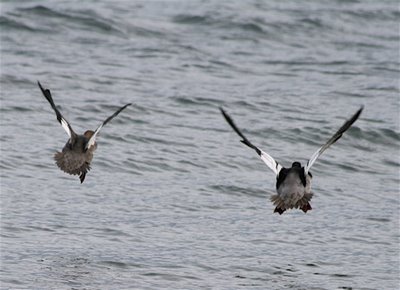 Beautiful, beautiful, and just about as much fun as I know how to have. Thank you, mergansers; thank you, Canon image-stabilizing lens!
Beautiful, beautiful, and just about as much fun as I know how to have. Thank you, mergansers; thank you, Canon image-stabilizing lens!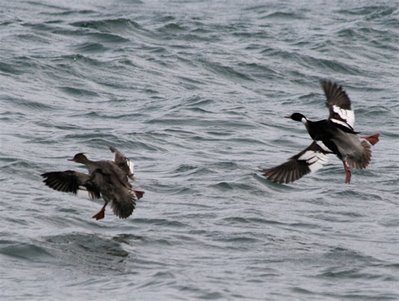 These two mergansers--common and red-breasted-- are among the largest ducks in North America. All the more amazing that they're cavity nesters. Red-breasted mergansers nest in Wisconsin, too, though I'm so used to seeing them on salt water in winter that it was strange to see them in summer on fresh water. They're almost tanklike--look at the proportion of head to body. The other thing I think is cool is their indeterminate number of tail feathers. Most birds have a determinate, even number--ten or twelve, and that doesn't vary. If I count right, these birds have something like seventeen tail feathers. You'll find this trait in grouse and turkeys too. Some have a dozen, some have 16, some have 19...I don't understand why that should be, but it is, and it's one of the things that bird painters need to know. Ah, birds.
These two mergansers--common and red-breasted-- are among the largest ducks in North America. All the more amazing that they're cavity nesters. Red-breasted mergansers nest in Wisconsin, too, though I'm so used to seeing them on salt water in winter that it was strange to see them in summer on fresh water. They're almost tanklike--look at the proportion of head to body. The other thing I think is cool is their indeterminate number of tail feathers. Most birds have a determinate, even number--ten or twelve, and that doesn't vary. If I count right, these birds have something like seventeen tail feathers. You'll find this trait in grouse and turkeys too. Some have a dozen, some have 16, some have 19...I don't understand why that should be, but it is, and it's one of the things that bird painters need to know. Ah, birds.






0 comments:
Post a Comment